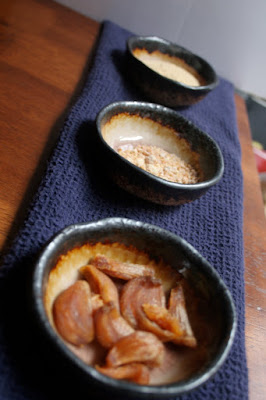The Taste Map, Umami and Kokumi (Complexities In Taste)
I remember learning about taste in elementary school. We were taught that there were four tastes: Sweet, Salty, Sour, and Bitter. Each of these tastes were sensed on a particular region of the tongue. The teacher handed out mimeographs that had a tongue drawn on them as a pop quiz. We were expected to write the name of each taste on the proper region of the tongue. I am sure I had to have gotten at least one wrong. Which means I got two wrong. Which means I failed the test. Which means my elementary school failed me.
Why?
Because, there is no truth to the taste map theory. It was information that I absorbed at an early age and never questioned it. It's like that time I read about the dreaded Hoop Snake and thought that there was a snake that would bite its tail and roll down hills in order to surprise its victim.
The Taste Map theory isn't just a little wrong. It has been debunked several times, including studies in the seventies, before I was even in elementary school. Not only can you taste all tastes on any region of your tongue, but you have taste receptors on places other than your tongue.
Whuuuuuh?
Let's take a look at some places where scientists have found taste receptors:
Oh, by-the-fucking-way, we have more than four tastes.
You've probably heard of umami or 'savoriness', which is present in mushrooms, tomatoes, fermented and aged products like soy sauce, fish sauce and certain cheeses. There was a brief period where tomato seeds were being used and abused on many menus because they were said to be rich in glutamates, which are amino acids associated with savoriness. If the word glutamate sounds familiar to you, that is because it is the G in MSG.
If you are a reader of this blog, you probably were already aware of Umami. But have you heard of Kokumi®? Kokumi® isn't immediately recognizable as a taste, but it is considered more of an enhancer. The Kokumi® effect takes advantage of calcium receptors on the tongue. When your tongue senses Kokumi®, it actually increases and extends sweet, salty and umami tastes. And yes, that's right, it has been ®'d by Ajinomoto. They actually own a registered trademark on a taste(ish-type-thingie). I wonder who would have owned Sweet®, if we had allowed such things eons ago.
So now we are almost up to six tastes. Which is pretty impressive since we have grown by 50% since I was in grade school. Which means we have almost caught up to the Ayurvedic, who already had six tastes: Sweet, Sour, Salty, Bitter, Pungent and Astringent.
Is the real lesson here is that Western society has a complete lack of nuance about taste?
Why?
Because, there is no truth to the taste map theory. It was information that I absorbed at an early age and never questioned it. It's like that time I read about the dreaded Hoop Snake and thought that there was a snake that would bite its tail and roll down hills in order to surprise its victim.
The Taste Map theory isn't just a little wrong. It has been debunked several times, including studies in the seventies, before I was even in elementary school. Not only can you taste all tastes on any region of your tongue, but you have taste receptors on places other than your tongue.
Whuuuuuh?
Let's take a look at some places where scientists have found taste receptors:
 |
| Figure 1: Taste Receptor Locations |
- Tongue (a.k.a. Everyone's Receptors).
- Soft Palate (a.k.a. High School Girlfriend's Receptors).
- Epiglottis (a.k.a. College Girlfriend's Receptors).
- Esophagus (a.k.a. Linda Lovelace Receptors).
- Lungs (a.k.a. That girl from that website Receptors).
Oh, by-the-fucking-way, we have more than four tastes.
You've probably heard of umami or 'savoriness', which is present in mushrooms, tomatoes, fermented and aged products like soy sauce, fish sauce and certain cheeses. There was a brief period where tomato seeds were being used and abused on many menus because they were said to be rich in glutamates, which are amino acids associated with savoriness. If the word glutamate sounds familiar to you, that is because it is the G in MSG.
If you are a reader of this blog, you probably were already aware of Umami. But have you heard of Kokumi®? Kokumi® isn't immediately recognizable as a taste, but it is considered more of an enhancer. The Kokumi® effect takes advantage of calcium receptors on the tongue. When your tongue senses Kokumi®, it actually increases and extends sweet, salty and umami tastes. And yes, that's right, it has been ®'d by Ajinomoto. They actually own a registered trademark on a taste(ish-type-thingie). I wonder who would have owned Sweet®, if we had allowed such things eons ago.
So now we are almost up to six tastes. Which is pretty impressive since we have grown by 50% since I was in grade school. Which means we have almost caught up to the Ayurvedic, who already had six tastes: Sweet, Sour, Salty, Bitter, Pungent and Astringent.
Is the real lesson here is that Western society has a complete lack of nuance about taste?



love your acerbic bitterness (yes, pun intended). been thinking about this a lot lately- in fact writing a similar post right now, only i come at it from the texture angle. you funny- keep it up.
ReplyDeletehah i have a followup coming about other sensations (including texture).
ReplyDelete